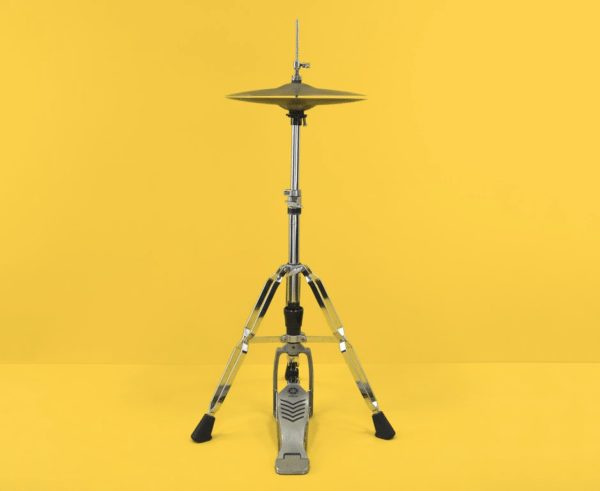Muscle Memory
Episode #6 of the course How to play the drums to (almost) every song you’ve ever heard by Dylan DePice
Day 6! You’re more than halfway there! In fact, you already know all the pieces to the puzzle; you already know what each of your four limbs needs to do in order to play the beat that’s the basis of almost every song you’ve ever heard.
• Right hand: 8th notes on the hi-hat (1 + 2 + 3 + 4 +)
• Left hand: snare on 2 and 4
• Right foot: bass drum on 1 and 3
• Left foot: keep it pressed into the floor*
*Why? A hi-hat is two cymbals upside down on top of each other (see picture below). Your left foot is on the pedal that opens and closes them. This beat is played with a closed hi-hat the whole time. So, all you’ve got to do is keep that foot firmly planted on the pedal/ground.
But just because you know all the pieces of the puzzle, that doesn’t mean you’re quite ready to crush this beat yet. Sorry.
Here’s how to get there: slowly build up the muscle memory of each limb individually and in relation to another limb.
For example, start by counting 8th notes.
1 + 2 + 3 + 4 +
(“One and two and three and four and”)
Then add the hi-hat (HH) by tapping your right hand on your left thigh with each count.
1 + 2 + 3 + 4 +
(“One and two and three and four and”)
Repeat it continuously without stopping until you feel like you could seamlessly have a conversation with someone at the same time without skipping a beat.
Once you can take your focus off your right hand, add bass drum (BD) by tapping your right foot on 1 and 3. I suggest lifting your knee way off the ground to exaggerate this and to fight the urge to tap your foot more frequently than you should. It also helps to emphasize your counting to make it easier.
1 + 2 + 3 + 4 +
(“ONE and two and THREE and four and”)
Count out loud. VERY LOUD, if you can. That way, it’s your primary focus because, as an old teacher of mine used to say, your brain gets it twice, once from saying it and once from hearing it.
Next, try just BD and SN. This way, you’re eliminating your right hand (HH) for now and just focusing on your right foot (BD) and your left hand (SN), which complement each other. Keep counting loud!
1 + 2 + 3 + 4 +
1 + 2 + 3 + 4 +
1 + 2 + 3 + 4 +
1 + 2 + 3 + 4 +
etc.
Then try HH and SN. Make sure your arms are crossed so your right hand is playing 8th notes on your left thigh (HH) and your left hand is tapping your right thigh when you say 2 and 4.
Switch back and forth between the combinations until you can do each one four times in a row without messing up.
Go as slow as you need to.
Don’t worry about playing in rhythm (with the exact same distance between each count) until you’ve got the physical part totally down. For example, it’s more important right now that you’re playing both HH and SN exactly at the moment when you say 2 than that you’re saying 2 exactly as far away from the and of 1 (the + immediately following 1) as the and of 2 (the + immediately following 2.)
Even though you’re not playing the full beat yet, you’re building up your ability to do so; you’re building muscle memory not only for each limb to do its own job but also for each limb to do its job in relation to what your other limbs are doing.
For example, by training yourself to play the bass drum pattern at the same time as the snare drum pattern and separately training yourself to play the bass drum pattern at the same time as the hi-hat pattern, you’re getting yourself physically and mentally ready to put all the pieces together.
You already know all these pieces; now practice combining them in various ways until you’re comfortable.
Tomorrow, we’ll put it all together.
Recommended book
Stick Technique: The Essential Guide for the Modern Drummer by Bill Bachman
Share with friends


